(1957) Directed by Val Guest; Written by Nigel Kneale; Based
on the BBC television play, The Creature, by Nigel Kneale; Starring: Peter
Cushing, Forrest Tucker, Maureen Connell, Richard Wattis, Robert Brown, Arnold
Marlé and Robert Brown; Available on Blu-Ray and DVD
Rating: ****
“The story, I suppose, made a moral point that the Abominable Snowman, if he was ever found, might not be abominable at all, but a touch better than ourselves.” – Nigel Kneale (from Shout Factory Blu-ray commentary)
“As you seek this creature, remember that you act in the name of mankind, and act humbly, for man is near to forfeiting his right to lead the world. He faces destruction by his own hand. Now, when a ruler, king is near death, he should not be seeking to extend his realm, but take thought, who might with honor succeed him. Remember this.” – Lhama (Arnold Marlé)
Of the many cryptids believed to walk the Earth, one of the
more plausible (well, at least more difficult to prove or disprove its
existence) creatures is the rumored Himalayan denizen, the Yeti, or “Abominable
Snowman.” Its stomping grounds are so remote, few Westerners have dared venture
where they can challenge its veracity. The discovery of a strange footprint by
explorer Eric Shipton in 1951, followed by a Daily Mail-sponsored expedition a
few years later, sparked awareness in the creature. The Yeti has popped in and
out of news reports ever since, emerging most recently in 2019, with another
discovery of footprints by Indian Army soldiers.
Back in the mid-50s, however, the Abominable Snowman was fresh in the minds of the
public consciousness, leading to Nigel Kneale throwing his hat in the ring,
with his 1955 BBC teleplay, The Creature.
Hammer films acquired the rights to Kneale’s teleplay,
commissioning him to write the script, changing the title to The Abominable
Snowman (it was released in the U.S. under the clunkier title, The
Abominable Snowman of the Himalayas). Peter Cushing, Wolfe Morris and Andrew
Marlé reprised their roles from the TV version. Director Val Guest and Kneale didn’t
always see eye-to-eye regarding the adaptation. Guest liked his screenplay, but
felt as-is, it was “too verbose” for filming, making some cuts along the way.
The Tibetan monastery set*/** was built at Bray Studios, while the climbing
scenes, which required a much larger sound stage, were shot at Pinewood Studios.
Guest enhanced the climbing scenes with location shots of climbers (doubling
for the actors) in the French Pyrenees.
* Fun Fact #1: Production designer Bernard Robinson’s ornate set was subsequently recycled for other Hammer productions, including Terror of the Tongs, and the non-Hammer Fu Manchu series of films, with Christopher Lee.
** Fun Fact #2: In order to cast the many residents of the monastery, a call went out for multiple Chinese waiters from London-area restaurants.
Continuing the dubious tradition of non-Asian actors playing
Asian characters, German-born actor Arnold Marlé portrays the resident Lhama,
the film’s spiritual center. Despite the questionable casting, Marlé handles
the character with reverence and gravitas. He exudes a calm exterior, masking
anxiety that the pending American/British Himalayan expedition will result in upsetting
a delicate balance that’s existed for generations. In one key scene, he implores
Dr. Rollason (Peter Cushing) to act with honor when embarking on his endeavor.
Dr. Rollason, as played by Cushing,* is inquisitive to a fault, enthralled by the legends of the Yeti, but respectful of the Lhama and his people’s customs. Maureen Connell plays his long-suffering wife, Helen (the character was named after Cushing’s wife), who supports her husband’s research, but fears for his safety. Compared to many 1950s depictions of women in genre films, her character is a breath of fresh air. She’s smart, independent, and not afraid to voice her objections to her husband’s risky adventures or the company he keeps. When the fate of Rollason’s team is in question, she promptly rallies her own team to mount a rescue mission.
* Fun Fact #3: According to director Val Guest, Peter Cushing
came to be known by the cast and crew by the nickname, “Props” Cushing, due to his
tendency to bring his own items on the set (such as a tape measure or other
tool), if he felt they would enhance his scenes.
Compared to the urbane, introspective Rollason, the ironically named Tom Friend (Forrest Tucker)* is brash and opportunistic. Superficially, he shares Rollason’s enthusiasm for finding the Yeti, but his motivations are purely selfish. As a self-avowed purveyor of multiple shady ventures and former gun runner, he’s only looking to make a quick buck. Similar to Carl Denham in King Kong, he’s a fast-talking con-man who only wants to find the mysterious creature so he can exploit it. For people like Friend and his men, the natural world is there to exploit rather than revere, a sentiment shared by seasoned tracker Ed Shelley (Robert Brown). He refuses to see the Yeti as anything other than an animal, which ultimately becomes his (and Friend’s) undoing.
* Fun Fact #4: Although Tucker was said to boast about his arduous climbing scenes in the film, according to Guest, he never left the studio.
Guest opted for more of a newsreel quality with the film rather than a stagey appearance. He wasn’t enamored with the widescreen format, dubbed “Hammerscope” (in actuality, Hammer’s re-branded version of Dyaliscope), an anamorphic process similar to Cinemascope, which required compositions across the expanded frame. In spite of Guest’s objections, the widescreen format works nicely for the climbing scenes/footage of the “Himalayas,” providing a more expansive look to the modestly budgeted production. As for the Yeti themselves, Guest (in opposition to Kneale’s opinion) desired a less-is-more approach, preferring the audience members to create their own picture of the creatures’ appearance. Although a full-scale Abominable Snowman body was created, we’re only treated to a brief glimpse or two of the hulking cryptids.
Kneale introduces a number of fascinating concepts in the
film. Among the most intriguing notions (which seems counter to many other
works of fiction about the Yeti and similar rumored hominid species), the creature
doesn’t represent a missing link between man and ape, but an offshoot from a
common ancestor. The film also speculates the Abominable Snowman might possess
abilities that surpass our own, including some form of telepathy. The creatures
seem to anticipate what the men in Friend’s expedition are planning. By the
same token, they inherently understand that Rollason means them no harm. Kneale
makes it clear that we have more to fear from ourselves than the Yeti (a common
theme in his stories is that we, not an outside force, are the ultimate
instrument of our destruction). The Yeti are not an evolutionary dead-end, as
their isolation from human society might suggest, but possibly more evolved
than us (Rollason remarks, “Suppose they’re not just a pitiable remnant waiting
to die out. They’re waiting, yes, but waiting for us to go.”). Another
prominent theme is the push-pull between the known and the unknown, the seen
and the unseen. The early scenes at the monastery establish the friction when the
arrogance of the West meets the wisdom of the East. Several characters,
excluding Rollason, continually express their lack of humility or appreciation
for the indigenous culture, referring to the Tibetans as “ignorant,” while refusing
to understand or appreciate their way of life. In contrast, because he’s endowed
with a more respectful, worldly outlook, Rollason is better equipped to confront
the mystery of the Yeti than his counterparts.
The Abominable Snowman reminds us that we haven’t yet catalogued all the world’s species, and some surprises might remain to be discovered. If the bombastic American trailer’s hyperbole is to be believed, viewers might expect to see a “hellish half-world of horror.” Audiences prepared for such a movie might have been in for a jolt when instead, they encountered a thoughtful, deliberately paced rumination on the Yeti myth, with a clash of cultures and ideologies. If anything, it’s a speculative adventure tale that owes more to Hammer’s science fiction films, such as X: The Unknown and the Quatermass titles, than their subsequent gothic horror offerings. The Abominable Snowman doesn’t provide all the answers, but realizes things work better with a little mystery. As with its protagonist Rollason, the film understands that some secrets are better left kept that way, for humanity and the Yeti’s sake.
Sources for this article: Shout Factory Blu-ray commentary by Val Guest and Nigel Kneale; The Hammer Story, by Marcus Hearn and Alan Barnes; National Geographic, “This Man Searched for the Yeti for 60 Years– And Found It,” by Simon Worrall; Indian Express, “What is Yeti?”

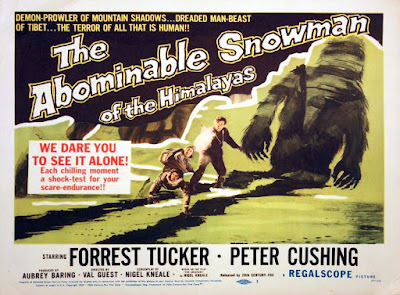
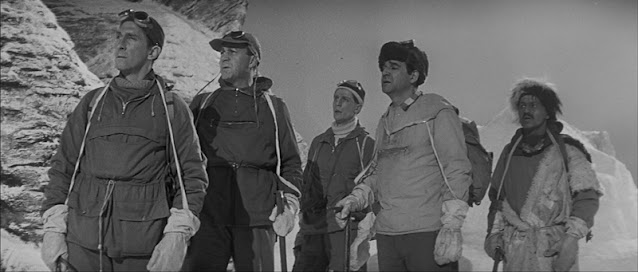
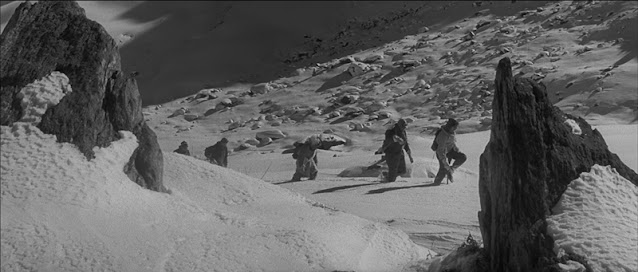
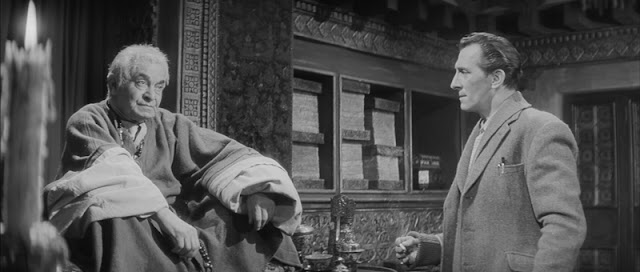



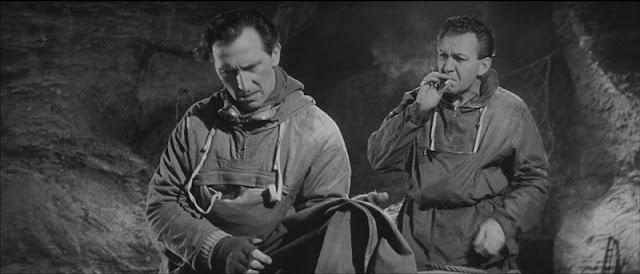

Yes, it's talky, but then so are a lot of good dramas. And this IS a drama, rather than a horror movie (although you could easily classify it as a horror movie, given the fates of some of the characters). There's such a sense of doom throughout the film - but who for?
ReplyDelete"Compared to many 1950s depictions of women in genre films, her character is a breath of fresh air"
Hadn't thought of that, but it's a very good point - they genuinely thought about the character: this is a woman who lives on the road in the mountains, not a bikini contestant lol. I can think of a couple of 1950s Hollywood genre movies that I can barely watch - and in one case genuinely can't watch - because the sole woman is such a badly-written idiot, often redeemed purely by the actress's performance!
I agree with the drama. In this case, the dialogue enhances the film, igniting the viewer's imagination (something sorely lacking in many newer genre films, where elaborate effects fill in the blanks).
DeleteConnell's character is refreshingly substantial, thnks to Kneale's three-dimensional profile, and her winning performance.
Wait!
ReplyDeleteNo yeti musical interlude, like in shriek of the mutilated?! Lol
Seriously, great review, Barry! I haven't seen the abominable snowman oh, but it sounds rather fascinating. Especially the intriguing notions of the mythical creature.
Sadly, no musical interlude (although it seemed oddly appropriate in Shriek of the Mutilated)
DeleteThanks, John! I'd love to hear your thoughts about it. I think it's safe to say it's probably the most cerebral Yeti film ever made. ;)
One of my favorites of Forrest Tucker's films, and performances. Atmospheric and intriguing.
ReplyDeleteIt's certainly one of the most throughtful cryptid movies, and it keeps getting better with each viewing.
DeleteForrest Tucker did three sf films that I frankly love. This is the best of them. Nigel Kneale's works never disappoint, and Peter Cushing as the scientist of the explorers, well, you just can't top that. Period.
ReplyDeleteOne note: upon a recent viewing, I've come to believe that Tucker's character is self-identified as "Tom Friend" but in actuality is a nom de guerre. He's hiding his true identity from the others with such an obviously assumed name. I hope someone else can take the time and see if they agree.
I don't think you can go wrong with a Kneale-penned script. He always infuses his stories with many thoughtful touches.
DeleteRegarding Tom Friend, that makes a lot of sense. It certainly fits the character.
I just watched this myself. It is one of the few Yeti/Bigfoot movies I actually like precisely because it isn't really a Yeti/Bigfoot movie. More often than not, those tend to be mindless. This film is the exact opposite.
ReplyDeleteI too noted the strength and independence of Connell's character. That the film still contains some cracks at the expense of women, makes Helen leading the rescue expedition that much more satisfying.
I think it's safe to say this is one of the most cerebral explorations of the Yeti myth, thanks to Kneale's script. In addition to Connell's character, it's refreshing to see a '50s movie where the creatures are peaceful for once.
Delete